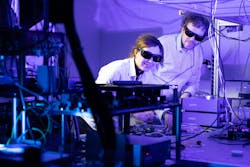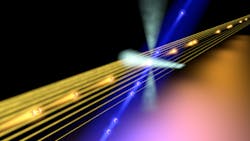A team of researchers from Leibniz University Hannover (Germany) and the University of Strathclyde (Scotland) recently experimentally proved the interference effect between thermal light and parametric single photons also leads to quantum interference with the background field—which means the background field can’t simply be ignored and subtracted from calculations, as was previously believed to be the case.
They originally set out to explore the Hong-Ou-Mandel (HOM) effect within the frequency domain between two imperfect single-photon states from a parametric down-conversion source.
“Our first results motived us to further explore this effect and how it is affected by different photon statistics, such as a thermal field and a heralded single-photon state,” says Professor Michael Kues, head of the Institute of Photonics at Leibniz University Hannover.
Hong-Ou-Mandel (HOM) effect
What exactly is the HOM effect? “The HOM effect is an exclusively nonclassical phenomena, discovered in 1987,” explains Anahita Khodadad Kashi, a Ph.D. student who works with Kues on photonic quantum information processing research at the Institute of Photonics (see Fig. 1). “It’s a two-photon quantum interference effect with no classical counterpart. Since its discovery, the HOM effect has found applications within quantum technology research.”
One concrete example of its application is for measurement-device-independent quantum key distribution (MDI-QKD), an infosec field with potential to revolutionize the current communication methods and usher in the era of the quantum internet. Another significant application of the HOM effect is for quantum metrology, which enable an unprecedented measurement resolution by preparing N00N states (a quantum mechanical many-body entangled state).
“The HOM effect is widely implemented in spatial degrees of freedom requiring a balanced beam splitter, and it’s been studied for different photon statistics as input fields,” says Khodadad Kashi. “We explored this effect between a thermal field and a heralded single-photon state, and surprisingly discovered that multiphoton events also contribute to improving the visibility (engage in the quantum interference).”
They turned to electro-optic phase modulation to probe the HOM effect in the frequency degree-of-freedom between a thermal field and a heralded single-photon state (see Fig. 2). “We used a programmable wavelength-selective switch as a standard telecommunication component for our system, as well as a pulsed laser source and a periodically poled lithium niobate waveguide,” says Kues. “And we used superconducting nanowire single-photon detectors (SNSPD) at the detecting stage.”
An important aspect of the team’s experimental setup was its reconfigurability, which enables its integration into the scalable future quantum networks.
Multiphoton components
When the team explored how the visibility of the HOM effect is affected by multiphoton contamination, “we disproved an assumption that multiphoton components would only impair visibility and can therefore be subtracted in the calculation,” says Khodadad Kashi.
This new fundamental characteristic “wasn’t considered in previous calculations,” says Khodadad Kashi. “Our newly developed model can predict the quantum interference and we can measure this effect in an experiment.”
Intriguingly, the team’s work reveals a contributing role for the multiphoton components in imperfect parametric single-photon sources, which are widely deployed. “For quantum networks, there was a firm common belief among researchers in terms of considering a mere degradative role for the multiphoton components,” says Kues. “But our experimental discovery accompanied with our novel theoretical model proves otherwise—and it has potential implications for the security of communications in MDI-QKD.”
Before arriving at their final conclusions and discovery, the team faced challenges interpreting their experimental results. “When we applied the common method for retrieving the HOM visibility, we got a physically impossible result,” says Khodadad Kashi. “It motivated us to look into this in more detail. With a new model, we were able to explain the experimental results—demonstrating that multiphoton components engage positively in the visibility.”
Their a-ha! moment really hit when they were able to explain the observed phenomena by a theoretical model they derived—it clearly explains the source of additional contribution to the visibility (it comes from the interference of the thermal parts of the fields). “At this point, we knew we’d come to a nontrivial discovery within the field,” she adds.
One current challenge within the quantum research realm “is the application of imperfect single-photon sources such as a heralded state from a spontaneous parametric down-conversion process,” says Kues. “Such an approximation of single-photon states is unavoidably accompanied by multiphoton contaminations, which can cause security gaps as quantum interference of different states of light is considered. In our work, we gave prominence to the role that multiphoton components can play in improving HOM visibility. This aspect needs to be considered when interpreting HOM visibility as a measure for secure communications.”
Quantum researcher Lucia Caspani at the University of Strathclyde was the first to test out the team’s new approach—and it helps provide a better understanding of quantum phenomena.
MDI-QKD
The most likely application of the team’s work is MDI-QKD, where the security of key establishment between legitimate end users relies on precise interpretation of the HOM effect and sources that contribute to HOM visibility. “Enabling highly secure QKD brings us one step closer to a future vision for the era of the quantum internet,” says Khodadad Kashi.
What’s next? “To study this effect in higher-order quantum interference systems,” says Kues.
FURTHER READING
A. Khodadad Kashi, L. Caspani, and M. Kues, Phys. Rev. Lett., 131, 233601 (Dec. 4, 2023); doi:10.1103/physrevlett.131.233601.


